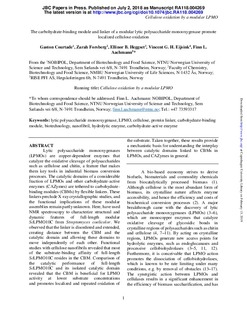The carbohydrate-binding module and linker of a modular lytic polysaccharide monooxygenase promote localized cellulose oxidation
Courtade, Gaston; Forsberg, Zarah; Heggset, Ellinor Bævre; Eijsink, Vincent; Aachmann, Finn Lillelund
Journal article, Peer reviewed
Accepted version
Permanent lenke
http://hdl.handle.net/11250/2588111Utgivelsesdato
2018Metadata
Vis full innførselSamlinger
Originalversjon
Journal of Biological Chemistry. 2018, 293 (34), 13006-13015. 10.1074/jbc.RA118.004269Sammendrag
Lytic polysaccharide monooxygenases (LPMOs) are copper-dependent enzymes that catalyze the oxidative cleavage of polysaccharides such as cellulose and chitin, a feature that makes them key tools in industrial biomass conversion processes. The catalytic domains of a considerable fraction of LPMOs and other carbohydrate-active enzymes (CAZymes) are tethered to carbohydrate-binding modules (CBMs) by flexible linkers. These linkers preclude X-ray crystallographic studies, and the functional implications of these modular assemblies remain partly unknown. Here, we used NMR spectroscopy to characterize structural and dynamic features of full-length modular ScLPMO10C from Streptomyces coelicolor. We observed that the linker is disordered and extended, creating distance between the CBM and the catalytic domain and allowing these domains to move independently of each other. Functional studies with cellulose nanofibrils revealed that most of the substrate-binding affinity of full-length ScLPMO10C resides in the CBM. Comparison of the catalytic performance of full-length ScLPMO10C and its isolated catalytic domain revealed that the CBM is beneficial for LPMO activity at lower substrate concentrations and promotes localized and repeated oxidation of the substrate. Taken together, these results provide a mechanistic basis for understanding the interplay between catalytic domains linked to CBMs in LPMOs and CAZymes in general.
